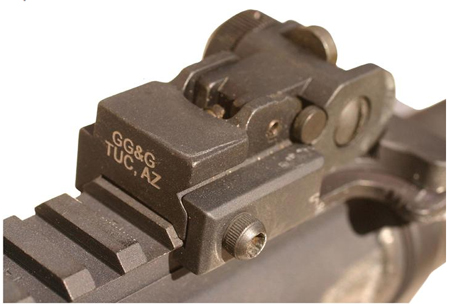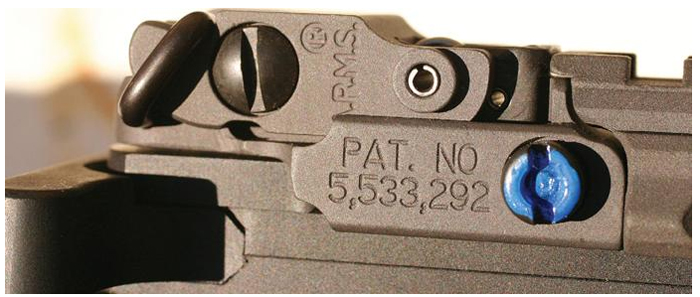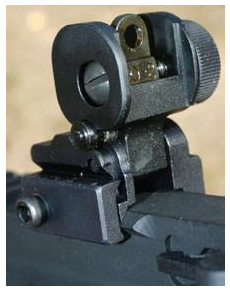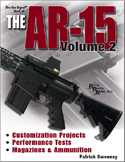 |
| The GG&G A2 is compact, solid, windage-adjustable and works just like an A2. Hard to beat. |
The AR-15 is not like other rifles. In the old days, if you wanted a new stock for a rifle you could pick up the process anywhere between sawing the plank off the timber, to applying a finish to a pre-shaped, pre-bedded stock. Not so the AR. Unless you happen to have a milling machine and the experience, you aren't going to be carving a new stock/sight/ whatever for your AR out of a block of aluminum, steel or plastic.
That's the bad news.
 |
| The Duostock looks odd, but provides a solid and comfortable surface for those who use the high-hold shooting style. |
The good news is that there are a lot of companies who have already done that for you. In the course of writing this article I did a quick web search for “AR-15 accessories” and came up with 712,000 hits. That's a lot of accessories. And someone out there has made it their mission to bolt every single one to an AR that is humanly possible. Me, I like the AR as it is: light, handy, convenient. But there are a few places where prudent selection of accessories can make it handier and more convenient, even if we do make it a tad bit heavier. Let's take a look at a few, working from back to front.
If you have a solid buttstock and want more magazine carrying capacity, you can lash on a Blackhawk mag pouch. I used to think these were pretty “mall-ninja” but I've seen lots of them in photos in Iraq and Afghanistan. The troops love them. Just be aware that once it is on you aren't going to be shooting from the other side of the AR. The mag gets in the way. To avoid that, install a Rase stock. The Rase stock uses the hollow interior as a place to store a spare magazine. You give up the trapdoor storage, but gaining a loaded magazine is worth it. Unlike the stock pouch, you can get the spare out without even taking the stock from your shoulder. Those with a tele-stock might want to consider the new Command Arms slider. It has an improved cheekrest, and a compartment that holds spare batteries. Given the number of add-ons we now have that are battery-powered, having spare cells close at hand is a good idea. The CAA stock also has a Picatinny rail and mag holder to put an extra mag on the off-side of the stock. If you already have a tele-stock and slider that works, and you just want battery storage, then CAA also has a sidesaddle. It clips over your slider and holds batteries in a pair of tubes.
 |
| Here we have the GG&G MAD, an EOTech Holosight, and the Redi-Mag – all on one rifle. Not much extra weight, and worth every ounce. |
Many shooters have been taught to keep their head erect when aiming. The problem with that approach is that the toe of the stock then digs into your chest just above your collar bone. The Duostock has an extension shaped like your chest that gives you a solid stock surface instead of a point. For those used to the “high hold” method, it works great. For those using the old method, the Duostock won't be in your way. One thing to keep in mind when getting a replacement stock for your carbine: there are two tube diameters. There is the mil-spec diameter, and the other, larger, tube. If you have a Colt, a Vltor or an LMT, you have a mil-spec tube. All others are larger. It does matter when you go to fit your new stock on.
Getting a sling on an AR is easy, right? Just lash a strap to the supplied loops. But what if you want something more useful than the traditional sling? Or you want to use a side sling. One approach is to call GG&G and get their side-sling adapters. You must have a telestock for the rear, but with the side rings you can have a sling on the left side of your AR. If you get the Sling ‘n Light Combo up front you can mount a sling and have a place to put a light. It bolts right into the front sight housing, and stays out of the way. For those who want a single-point sling, GG&G is one of many who make replacement plates. You remove the stock (standard) or unscrew the castle nut and buffer tube (telestock) and then use the adapter plate. You have a choice of ring or loops, depending on what kind of attachment you need for your sling. Some departments don't allow any gunsmithing on an issue weapon that requires tools. If you need to take so much as a screwdriver to the rifle, you can't install the new and improved part. You can install a single-point sling adapter in such cases. Both GG&G and Midwest Industries make slip-on adapters. Remove the slider of your telestock. Slide the adapter over the buffer tube and tighten down. Replace slider. You're done, except for attaching the sling itself. And if the department wants the weapon back, you can simply remove the adapter before you turn in the weapon. (It's your money, right?)
 |
| The A.R.M.S. 40L is a low-profile BUIS that is spring-loaded and very cool. |
If we all had the same-sized hands, there would only be one size that gloves were made in. If we have different-size gloves, why not pistol grips? The standard works fine for a lot of shooters, but for those who find them lacking, you can go with the Ergo Grip. In shape it is much like the H-K MP5. It also has a riser that comes up the rear of the AR lower, to fill the gap and change the angle of your wrist. If you want more flexibility in selection and adjustment, Magpul makes a modular pistol grip which you can bolt together to the size and contour you prefer. Buffer Technologies makes a pistol grip that is better-contoured than the mil-spec grip, and can be used to store spare batteries or spare parts.
The buttstock isn't the only place you can use to keep extra ammo. The simplest are the mag Cinch from Buffer Technologies, and the mag coupler from Command Arms. Each of them clamps two magazines together. To reload after emptying the first magazine, just grab the mags, press the mag button, pull down, shift over and shove up. You now have more ammo. You need to keep one thing in mind: stagger your mags. The right-hand magazine should be slightly lower in the clamps than the left. Otherwise, it may interfere with ejection of the empty brass when you're firing from the left-hand magazine. The heavier, but better-protected spare magazine option comes from Redi-Mag. The Redi-mag (available from The Wilderness) is a sheet-steel housing that acts as a secondary magazine well. Once you have two loaded magazines in your AR, switching is simple. Reach up and grab the spare. Press the mag button. The empty magazine will drop free. Pull the spare out, shift and shove. Be careful. Between the buttstock storage and the Mag Cinch or Redi-mag, you can have so much ammo ready you can't carry your AR.
 |
| Midwest Industries makes a very good A2 BUIS that folds. |
The big advantage rifles have over other firearms is accuracy at range. To make best use of that accuracy you need more than just irons. (You still need iron sights, but if possible use optics first.) The traditional optics are magnifying optics. Leupold has blended the magnifying optic with a red-dot sight in their CQ/T. You have a regular black reticle (ring and dot) that you can light up with a battery. If the battery dies, you still have a sight. And you can zoom from 1X to 3X for more precision. If you want more than just the 1-3X range then Leupold makes no end of regular scopes that you simply mount as if the AR were any other rifle. Any other rifle with a flat-top, so you can use a hell-for-tough LaRue ring and mount. The sturdiness of LaRue mounts exceeds that of the optics they hold, and sometimes even the rifle itself.
If you do not need magnification (and a lot of AR shooting doesn't) then a red-dot scope is the hot ticket. At the top end you have Aimpoint and EOTech duking it out. Both make extremely tough scopes. Both work hard at improving their scopes. And both deliver superb aiming devices. However, and this is no slam, you can spend almost as much on optics and a mount, as you spent on your rifle. For some of us that isn't a problem. For guys (and gals) who want to learn how to shoot, it can be an obstacle.
Adco to the rescue. Their tactical red-dot looks enough like the Aimpoint that even the most status-conscious mall ninja would be happy. You can buy the Adco, with mount, for about what you'd pay for a mount alone for the Aimpoint. For the beginning shooter, the math is easy: Aimpoint and mount, or EOTech, versus Adco and several thousand rounds of practice ammo. Once you've gotten practice, and know you need more scope, then get the better optics. Although for most shooters, the extra margin of durability is never going to be needed. Sorry, Aimpoint and EOTech, but true. Most of us will not collect paychecks for jumping out of perfectly good aircraft or SWAT vans.
Flat-top rifles are all the rage. But a flat-top rifle removes one of the essential parts of a rifle, the rear sight. Even the most durable optics break. Even the most energy-packed battery dies. You'll need iron sights, in our case the Back Up Iron Sight, or BUIS. The GG&G MAD (Multiple Aperture Device) is a very compact sight that has two sizes of aperture in it. For those using an A.R.M.S. forearm, they make two BUIS: the 40 and the 40L. The difference is that the 40L is the lower of the two, and fits right behind the top rail of their Selective Integrated Rail. For those not worried about fitting in with accessory rails, and just want a durable and useful sight, Midwest Industries makes their A2 ERS. It has windage adjustments just like the A2 sight, and folds to be out of the way when using your optics.
 |
| Aimpoint scopes can be mounted in other mounts, too, like this A.R.M.S. #68. |
The hottest new item for the AR is a tactical forearm, or tactical handguards. With lots of rails, there is plenty of room to bolt on more gear. Even if you do not need to bolt a PEQ-2 laser targeting designator, or an M-203 grenade launcher, the railed handguard does a good thing for you:it free-floats your barrel. Free-floating almost always improves accuracy. A.R.M.S. makes the S.I.R. which is cool, rugged, gets high marks in the CDI scale (chicks dig it) and works like a champ. It is also just a bit large in diameter. If you have medium-sizedhands it may be large for you. Small-handed shooters may find it too big. Midwest Industries makes railed handguards in all lengths, and even a pair that simply replace your regular handguards. Yes, you lose the free-float option, but you get rails and don't have to use any tools. Samson makes railed handguards that are perhaps the toughest around. (I haven't whacked all brands against a windowsill yet.) If you do have small hands, GG&G makes the best option for you – and for us large-handed shooters, too. Their railed handguard has removable rails. If you want, you can strip the rails off except the one actually holding your light. That leaves a very compact free-float tube that is great for grasping.
And speaking of lights, you can now get as much or as little light on your subject as you like. There is no end of flashlight holders that clamp right to your railed handguard. You can install a low-power light for just walking around in the dark, or you can use a Surefire 900-series light pumped up to 500 lumens. That will almost give heat blisters to what you're lighting up. If you want something not removable, the 500 series replace your handguards and also give you the option of up to 500 lumens. For smaller lights, the Surefire X200, the Streamlight M3 or M6, and almost any other handgun-designated tactical light will attach right to your railed handguard. They are all simple to install, and will fit in your pocket.
In all this discussion, you have to keep one word in mind: restraint. If you went and attached all the possible extra gear to your AR, you can more or less double its weight. It is easy to take a carbine of just under seven pounds and bolt more than seven pounds of stuff to it. An H-Bar would take more work, but you could come close to doubling its nine pounds. You can also break the bank on accessories. If you buy a good AR for a grand, you could easily double your cost with accessories. Remember, you have to actually pick up and carry your AR in order for it to do you any good. And you have to be able to afford practice ammo, if you expect to have any skills to show.









